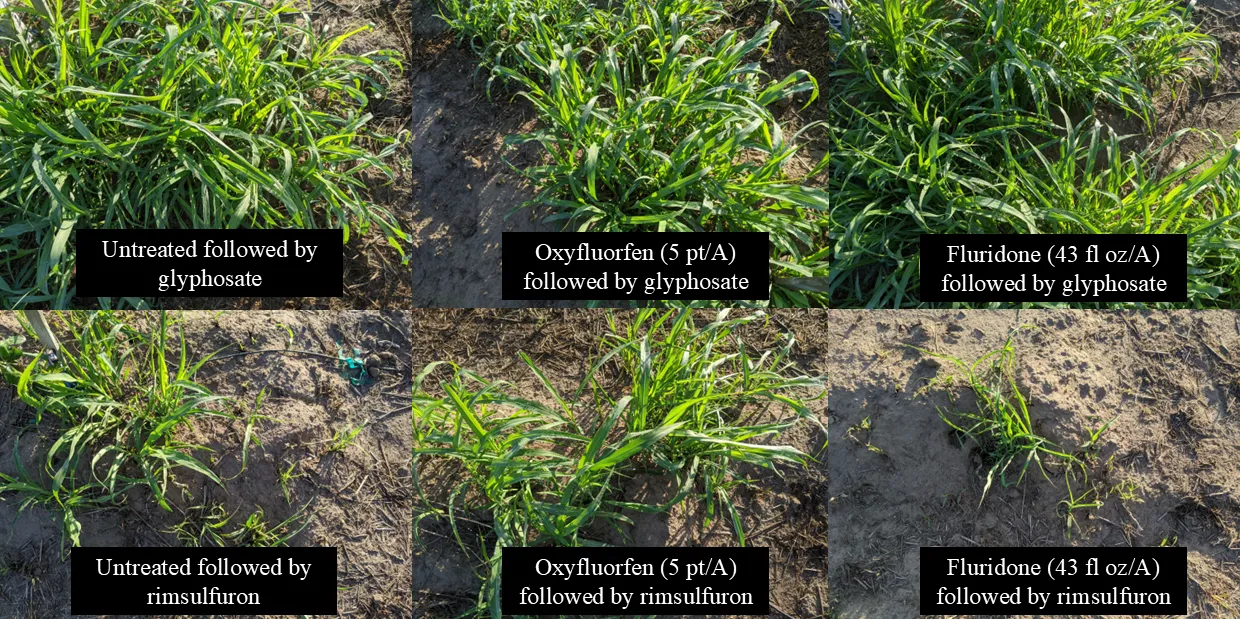To provide better recommendations on how to best use rimsulfuron and other residual herbicides to target johnsongrass I established a set of trials in Shasta and Tehama county prune and walnut orchards in winter and spring of 2025. I had two primary goals: first, to test if early spring rimsulfuron applications were effective for control of johnsongrass and second, to determine whether treatments were primarily affecting seedlings or established populations.
In winter (early February) I applied pre-emergent herbicides including either fluridone (Brake On!, 43 fl oz/A [not registered in CA]) or oxyfluorfen (Goal 2XL, 5 pt/A), along with an untreated control, to account for any seedlings that might germinate through the duration of my trials. In spring (early March) I applied either rimsulfuron (Revolt, 2 or 4 oz/A) or glyphosate (Roundup Powermax 3, 2 pt/A) just before or after shoot emergence from underground rhizomes. Glyphosate was used as a control treatment to account for any post-emergent activity of rimsulfuron on emerged shoots in order to evaluate only the soil residual effects of rimsulfuron. Very little plant material was available for direct absorption of herbicide through leaf tissue at the spring timing, so this is not a preferred use of glyphosate but was simply used as a more suitable control than untreated johnsongrass. Glyphosate can be very effective in the spring but requires adequate leaf material for absorption into the plant. All together four trials were installed, at three different locations. All treatments were accompanied by a half inch of rain within a week of application, washing the herbicide off thatch and leaves and down into the soil.

In all cases the rimsulfuron treatments were responsible for most of the weed control in my plots. Plots that received winter preemergent treatments were only marginally different from plots that were untreated in the winter, if followed by glyphosate in the spring. Only plots that received rimsulfuron in spring had any significant reduction in johnsongrass coverage or biomass. This suggests that the effects of rimsulfuron observed on johnsongrass populations were not primarily from soil residual effects on seedlings but that the perennial rhizomes themselves were affected. Winter treatments added additional johnsongrass control when combined with rimsulfuron only in two of my four trials, and this effect was seen later in the spring as seedlings began to germinate.
The primary takeaway from this research was that rimsulfuron applications in early March resulted in a 40-90% reduction in johnsongrass weed coverage and biomass that lasted past the end of the study, which was in early May. This was a reduction relative to the control treatment with glyphosate alone, suggesting that post-emergent absorption of rimsulfuron is likely not the primary mechanism of control, but rather activity in the soil. Rates of 4 oz/A were much more effective than 2 oz/A and the addition of glyphosate to the tank mix seemed to slightly increase efficacy.
Further reading on my research:
Progressive Crop Consultant: click here
Sac Valley Orchards: click here
